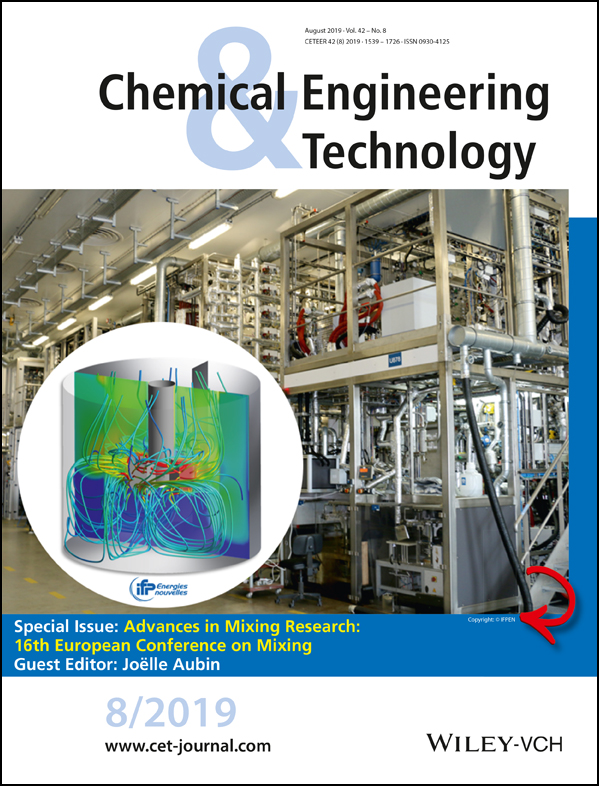Dispersion and Phase Separation of Water-Oil-Amphiphile Systems in Stirred Tanks
Corresponding Author
Lena Hohl
Technical University Berlin, Chair of Chemical and Process Engineering, Fraunhoferstrasse 33–36, 10587 Berlin, Germany
Correspondence: Lena Hohl ([email protected]), Technical University Berlin, Chair of Chemical and Process Engineering, Fraunhoferstrasse 33–36, 10587 Berlin, Germany.Search for more papers by this authorVanessa Röder
Technical University Berlin, Chair of Chemical and Process Engineering, Fraunhoferstrasse 33–36, 10587 Berlin, Germany
Search for more papers by this authorMatthias Kraume
Technical University Berlin, Chair of Chemical and Process Engineering, Fraunhoferstrasse 33–36, 10587 Berlin, Germany
Search for more papers by this authorCorresponding Author
Lena Hohl
Technical University Berlin, Chair of Chemical and Process Engineering, Fraunhoferstrasse 33–36, 10587 Berlin, Germany
Correspondence: Lena Hohl ([email protected]), Technical University Berlin, Chair of Chemical and Process Engineering, Fraunhoferstrasse 33–36, 10587 Berlin, Germany.Search for more papers by this authorVanessa Röder
Technical University Berlin, Chair of Chemical and Process Engineering, Fraunhoferstrasse 33–36, 10587 Berlin, Germany
Search for more papers by this authorMatthias Kraume
Technical University Berlin, Chair of Chemical and Process Engineering, Fraunhoferstrasse 33–36, 10587 Berlin, Germany
Search for more papers by this authorAbstract
Drop size distributions and phase separation behavior of water-oil-nonionic amphiphile systems are investigated using an in situ endoscope measurement technique and an external camera in stirred tanks in batch mode. The fitting procedure and the simulation results of a phase separation model are analyzed under the condition that either the swarm sedimentation speed or the mean drop size during sedimentation is known. The steady-state drop size distributions are self-similar over the whole range of process parameters, but not in the decaying turbulence field after agitation stop. The coalescence rate in the first seconds after agitation stop clearly affects the separation behavior, so that a prediction of the separation time based on the initial conditions in steady state is not trivial.
References
- 1 C. W. Kohlpaintner, R. W. Fischer, B. Cornils, Appl. Catal., A 2001, 221, 219–225. DOI: https://doi.org/10.1016/S0926-860X(01)00791-8
- 2 T. Pogrzeba, D. Müller, M. Illner, M. Schmidt, Y. Kasaka, A. Weber, G. Wozny, R. Schomäcker, M. Schwarze, Chem. Eng. Process. 2016, 99, 155–156. DOI: https://doi.org/10.1016/j.cep.2015.09.003
- 3 M. Schwarze, T. Pogrzeba, K. Seifert, T. Hamerla, R. Schomäcker, Catal. Today 2015, 247, 55–63. DOI: https://doi.org/10.1016/j.cattod.2014.06.026
- 4 D. Müller, E. Esche, T. Pogrzeba, M. Illner, F. K. Leube, R. Schomaecker, G. Wozny, Ind. Eng. Chem. Res. 2015, 54, 3205–3217. DOI: https://doi.org/10.1021/ie5049059
- 5 P. Schrader, A. Culaguin-Chicaroux, S. Enders, Chem. Eng. Sci. 2013, 93, 131–139. DOI: https://doi.org/10.1016/j.ces.2012.08.020
- 6 M. Kahlweit, R. Strey, P. Firman, J. Jen, R. Schomäcker, Langmuir 1988, 4, 499–511. DOI: https://doi.org/10.1021/la00081a002
- 7
P. A. Winsor, Trans. Faraday Soc.
1950, 44, 376–398.
10.1039/tf9484400376 Google Scholar
- 8 S. Burauer, L. Belkoura, C. Stubenrauch, R. Strey, Colloids Surf., A 2003, 228, 159–170. DOI: https://doi.org/10.1016/S0927-7757(03)00357-1.
- 9 E. J. Acosta, M. A. Le, J. H. Harwell, D. A. Sabatini, Langmuir 2003, 19, 566–574. DOI: https://doi.org/10.1021/la0261693
- 10 T. Pogrzeba, M. Schmidt, L. Hohl, A. Weber, G. Buchner, J. Schulz, M. Schwarze, M. Kraume, R. Schomacker, Ind. Eng. Chem. Res. 2016, 55 (50), 12765–12775. DOI: https://doi.org/10.1021/acs.iecr.6b03384
- 11 L. Hohl, J. Schulz, N. Paul, M. Kraume, Chem. Eng. Res. Des. 2015, 108, 210–216. DOI: https://doi.org/10.1016/j.cherd.2016.01.010
- 12 L. Hohl, M. Kraume, Chem. Eng. Res. Des. 2018, 129, 89–101. DOI: https://doi.org/10.1016/j.cherd.2017.10.027
- 13 M. Henschke, L. H. Schlieper, A. Pfennig, Chem. Eng. J. 2002, 85, 369–378.
- 14 T. Frising, C. Noïk, C. Dalmazzone, J. Dispersion Sci. Technol. 2006, 27 (7), 1035–1057. DOI: https://doi.org/10.1080/01932690600767098
- 15 L. L. Coulaloglou, C. A. Tavlarides, Chem. Eng. Sci. 1977, 32, 1289–1297.
- 16 Y. Liao, D. Lucas, Chem. Eng. Sci. 2009, 64, 3389–3406. DOI: https://doi.org/10.1016/j.ces.2009.04.026
- 17 Y. Liao, D. Lucas, Chem. Eng. Sci. 2010, 65, 2851–2864. DOI: https://doi.org/10.1016/j.ces.2010.02.020
- 18 J. Kamp, J. Villwock, M. Kraume, Rev. Chem. Eng. 2017, 33 (1), 1–47. DOI: https://doi.org/10.1515/revce-2015-0071
- 19 M. Kraume, A. Gäbler, K. Schulze, Chem. Eng. Technol. 2004, 27 (3), 330–334. DOI: https://doi.org/10.1002/ceat.200402006
- 20 C. Tsouris, L. Tavlarides, AIChE J. 1994, 40 (3), 395–406. DOI: https://doi.org/10.1002/aic.690400303
- 21 D. Ramkrishna, Population Balances Theory and Applications to Particulate Systems in Engineering, Academic Press, New York 2000.
- 22 J. E. Coons, P. J. Halley, S. A. McGlashan, T. Tran-Cong, Adv. Colloid Interface Sci. 2003, 105, 3–62. DOI: https://doi.org/10.1016/S0001-8686(03)00003-4
- 23 A. K. Chesters, Chem. Eng. Res. Des. 1991, 69, 259–270. DOI: https://doi.org/10.2306/scienceasia1513-1874.2010.36.142
- 24 C. Noïk, T. Palermo, C. Dalmazzone, J. Dispers. Sci. Technol. 2013, 34, 1029–1042. DOI: https://doi.org/10.1080/01932691.2012.735929
- 25 A. I. Mil'chenko, I. V. Domanskii, N. V. Vorob'ev-Desyatovskii, Russ. J. Appl. Chem. 2007, 78 (12), 2002–2007.
- 26 T. Pilhofer, D. Mewes, Siebboden-Extraktionskolonnen, Verlag Chemie GmbH, Weinheim 1979.
- 27 M. Ishii, N. Zuber, AIChE J. 1979, 25 (5), 843–855. DOI: https://doi.org/10.1002/aic.690250513
- 28 S. Hartland, S. A. K. Jeelani, Chem. Eng. Sci. 1988, 43 (9), 2421–2429.
- 29 M. Henschke, Dimensionierung liegender Flüssig-Flüssig-Abscheider anhand diskontinuierlicher Absetzversuche, VDI Verlag GmbH, Düsseldorf 1995.
- 30 N. Kopriwa, A. Pfennig, Solvent Extr. Ion Exch. 2016, 34 (7), 622–642. DOI: https://doi.org/10.1080/07366299.2016.1244392
- 31 L. Hohl, J. M. Schulz, M. Kraume, J. Chem. Eng. Jpn. 2018, 51 (4), 383–388. DOI: https://doi.org/10.1252/jcej.17we291
- 32 L. Y. Yeo, O. K. Matar, E. S. Perez de Ortiz, G. F. Hewitt, J. Colloid Interface Sci. 2003, 257, 93–107. DOI: https://doi.org/10.1016/S0021-9797(02)00033-4
- 33 S. Queste, P. Bauduin, D. Touraud, W. Kunz, J.-M. Aubry, Green Chem. 2006, 8, 822–830. DOI: https://doi.org/10.1039/b603973a
- 34 S. Maaß, J. Rojahn, R. Hänsch, M. Kraume, Comput. Chem. Eng. 2012, 45, 27–37. DOI: https://doi.org/10.1016/j.compchemeng.2012.05.014
- 35 P. Renze, A. Buffo, D. L. Marchisio, M. Vanni, Chem. Ing. Tech. 2014, 86 (7), 1088–1098. DOI: https://doi.org/10.1002/cite.201400004
- 36 K. E. Trætli-einarsrud, B. Panjwani, V. Pauchard, 10th Int. Conf. on Computational Fluid Dynamics in the Oil & Gas, Metallurgical and Process Industries, Trondheim, June 2014.
- 37 S. K. Panda, K. K. Singh, K. T. Shenoy, V. V. Buwa, Chem. Eng. J. 2017, 310, 120–133. DOI: https://doi.org/10.1016/j.cej.2016.10.102




